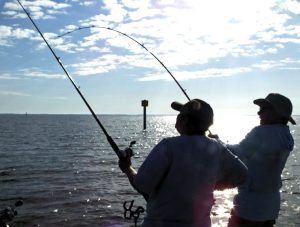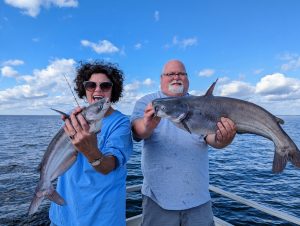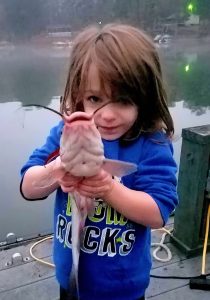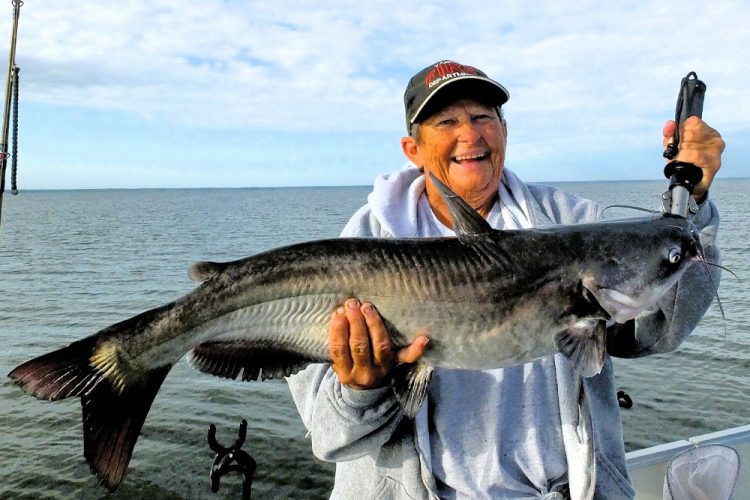Capt. Barbara “Mouse” Witherell said, “Smile! It’s fun to just be catfishing and fun to catch them!”
Catfishing with Women: It’s Seriously Fun
Story and photos by Terry Madewell
Catfishing with women adds unique and important perspectives.
Growing up in a rural area provided me the opportunity to enjoy and appreciate the great outdoors, and much of that pleasure revolved around catfishing on lakes along the Tennessee River.
One primary mentor in my youth was my maternal grandfather, Papaw, who was a skilled catfisherman. He taught me a great deal about catching catfish and the sport of fishing in general.
But his two daughters, my mom and my aunt, were key players in instilling the idea that fishing for the sheer fun of it was also reason aplenty to go catfishing. They enjoyed catfishing from a different perspective than Papaw. While serious about catching fish, catfishing was less of a means to an end, such as a stringer or a cooler of catfish for the table. It was a journey to be enjoyed, a fun-filled process from start to finish.

Fishing with these ladies helped me understand at a young age that working hard to find catfish was fruitful and that catching them should be celebrated. But unlike Papaw, when he or I caught a fish, the information gleaned from that success often triggered a transition in tactics to enhance future catches.
These women taught me how to celebrate the moments from when a catfish was hooked until landed and even afterward. They never hid a hooked catfish. They demonstrated that catching a catfish is a fun event. When one had a big fish hooked, everyone in the vicinity would know it from the shrill shrieking from the one fighting the fish, mingled with loud verbal coaching from the other.
Guys tend to downplay sharing the hooked-fish adventure, often preferring to hide the action so nearby anglers won’t see. All my male mentors taught me tricks to accomplish that feat.
These ladies enjoyed fighting the fish, milking maximum fun from the opportunity, and when they landed a fish, it was celebrated and shown off. Then, the challenge was passed on to the other to top it. If a fish was lost, verbal payback was immediate, yet always delivered in the spirit of good fun via laughter.

I’ve found that these experiences made me a more complete counselor when taking kids and grandkids fishing. It’s OK to celebrate even if someone sees your fishing hole. Mom’s theory about why it was acceptable was simple. Even if other anglers witnessed the hooked fish being landed, that fish already belonged to her.
I learned that every catfish has the potential to provide fun, laughter and happiness, including for those watching. On more than one occasion, another nearby angler would applaud the catch, acknowledging to others that the spirit of these ladies “makes my day.”
Catfish were never unceremoniously roped on a stringer or plopped in a cooler and hidden. When other anglers asked, ‘How’s the fishing?,’ they’d be treated to a view of the catch, and if they lingered, they’d hear the story of any big fish caught.
I’ve fished with other women in recent years who maintain the mantra of fun in catfishing.
Capt. Barbara “Mouse” Witherell is a veteran catfishing guide and the only female guide on the Santee Cooper lakes in South Carolina. She’s honed the ability to take the fun of fishing to a professional level. It’s one thing to be able to find fish, and she’s exceptional in that regard. But folks who fish with her are likely to return for future trips because she instills the fun factor at a high level.
Her positive energy when fish are hooked, along with verbal encouragement and support, enlivens the process. When fishing is slow, the fishermen on her boat don’t become quiet and somber. She emphasizes conversation and making personal connections with the fishermen, and spinning uplifting tales. When rods begin bending again, as they usually do, the conversations and connections continue while boating catfish.

Many women I’ve fished with also present an elevated sense of humor, and to be a catfish guide or first mate on a catfish guide boat means she’s capable of giving directions while cracking jokes.
One of the best I’ve seen is Shannon Sellers, wife of Santee Cooper catfish guide Eric Sellers. She serves as first mate on occasion when her own business allows. She gets into her “catch fish” mode and directs foot traffic on the boat at a high level while eyeballing the rigs for any telltale sign of a bite, all while keeping everyone entertained with her quick wit.
Her positive energy helps anglers relax, and she’ll discuss her insights into the fishing trip from a female perspective, presenting some mind-opening ideas for many. Not only does that make the specific trip more interesting and entertaining, but I’ve found that implementing some of those concepts later, when fishing on my own boat, worked well when taking others fishing.
A final thought revolves around the concept of teamwork that catfishing ladies possess. Their success is driven by their willingness to work hard and is enhanced by collaboration.
Papaw’s view wasn’t the same. I’ve found that blending his different perspectives with those of women I’ve fished with has been beneficial in learning how to catch fish while increasing enjoyment of the process.
These ladies have taught that when taking kids catfishing, the fun factor is key to a good beginning. If a youngster is ready to move up to a different skill and intensity level, I fall back on Papaw’s teachings. This leveling up has occurred with a couple of granddaughters.
The bottom line is that blending effort and detailed catfishing knowledge while instilling fun and camaraderie is the recipe for some seriously fun catfishing.
(Terry Madewell of Ridgeway, S.C., has been an outdoor communicator for nearly 50 years. He holds a degree in Wildlife and Fisheries Management and has a long career as a professional wildlife biologist/natural resources manager. He’s passionate about sharing outdoor adventures with others.)



